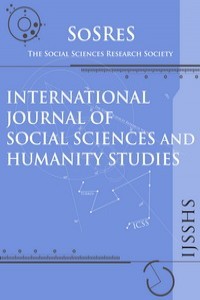RECRUITING OLDER VOLUNTEERS: FINDINGS FROM THE BELGIAN AGEING STUDIES
RECRUITING OLDER VOLUNTEERS: FINDINGS FROM THE BELGIAN AGEING STUDIES
volunteering, older adults, neighbourhood, environmental gerontology,
___
- Booth, Michael, Neville Owen, Adrian Bauman, Ornella Clavisi and Eva Leslie (2000), “Social- cognitive and perceived environment influences associated with physical activity in older
- Australians”, Preventive Medicine, Vol. 31, pp. 15–22. Bowling, Ann and Mai Stafford (2007), “How do objective and subjective assessments of neighbourhood influence social and physical functioning in older age? Findings from a British survey of ageing”, Social science and Medicine, Vol. 64, pp. 2533-2549.
- Cagney, Kathleen and Ming Wen (2007), “Social capital and aging-related outcomes. In I.
- Kwachi, S.V. Subramanian and D. Kim (Eds.)”, Social capital and health (pp.239-258). New York: Springer. Choi, Lona (2003), “Factors affecting volunteerism among older adults”, The Journal of Applied
- Gerontology, Vol.22, No. 2, pp. 179-196. Drooglever Fortuijn, Joos and van der Meer Marieke (2006). Gender and voluntary work in late adulthood in rural communities in the Netherlands. GeoJournal, 65, 381-392.
- Drooglever Fortuijn, Joos, Marieke van der Meer, Vanessa Burholt, Dieter Ferring, Sabrina Quattrini, Rahm Hallberg Ingalill, Germain Weber, and Clare Wenger (2006),” The activity patterns of older adults: a cross-sectional study in six European countries”, Populations, space and place, Vol. 12,pp. 353-369.
- Dury, Sarah, Tine Buffel, Liesbeth De Donder, Nico De Witte and Dominique Verté (2010),
- “Volunteering in later life: a citizenship perspective”, working paper. [In Dutch]. Field, Andy (2006), Discovering Statistics Using SPSS. London: Sage Publications.
- Fischer, Lucy and Kay Schaffer (1993), Older Volunteers. Newbury Park, CA: Sage Publications.
- Freeman, Richard (1997), “Working for nothing: the supply of volunteer labor”, J. Labor Econ.Vol. 15, pp. 140–167.
- Hodgkinson Virginia and Murray Weitzman (1996), Giving and Volunteering in the United
- States. Washington, D.C: Independent Sector. Home Office (2004), 2003 Home Office Citizenship Survey: people, families and communities
- Home Office Research Study 289. Home Office: London. House James, Karl Landis and Debra Umberson (1988), “Social Relationships and Health”, Science, Vol. 241, pp. 540–545.
- Kempen, Gertrudis, Els Brilman, Johan Heyink and Johan Ormel (1995), MOS Short-Form
- General Health Survey (SF-20), Groningen: Noordelijk centrum voor gezondheidsvraagstukken. Locke Michael, Alice Sampson and Julie Shepherd (2001), “Bowling alone: Community leaders in East London”, Voluntary Action, Vol. 3, No. 3, pp. 87-109.
- Macintyre, Sally and Anne Ellaway (1999), “Local opportunity structures, social capital and social inequalities in health: what can central government do?”, Health Prevention Journal of Australia, Vol. 9, pp. 165–170.
- Macintyre, Sally and Anne Ellaway (2003), Neighborhoods and health: an overview. (in: Kawachi, I. and Berkman, L. F. -eds., Neighborhoods and Health). Oxford University Press, Oxford, pp. 20–
- Marriott Senior Living Services (1991), Marriott’s Senior Volunteerism Study. Washington, DC:
- U.S. Administration on Aging. Nair, Kichu (2005),” The physically ageing body and the use of space”, (in: G.J. Andrews & D.R. Phillips -Eds., Ageing and place; perspectives, policy, practice), New York: Routledge, pp.110
- Peace, Sheila, Hans-Werner Wahl, Heidrun Mollenkopf and Frank Oswald (2007), “Environment and ageing”, (in: John Bond, et al.-Ed., Ageing in Society), London: SAGE, pp.209-234.
- Smith Jacqui and Denis Gerstorf (2004), Ageing differently: potential and limits.(in: Daatland SO, Biggs S -eds., Ageing and Diversity; multiple Pathways and Cultural Migrations ) Policy Press: Bristol, pp. 13–28.
- Tolsma, Jochem, Tom van der Meer and Maurice Gesthuizen (2009), “The impact of neighbourhood and municipality characteristics on social cohesion in the Netherlands”, Acta politica, Vol. 0, No. 0, pp.1-28.
- Van der Meer, Marieke (2006), Productivity among older people in The Netherlands: variations by gender and the socio-spatial context in 2002-03, Ageing and society, Vol. 26, pp. 901-923.
- Van der Meer, Marieke (2008), “The sociospatial diversity in the leisure activities of older people in the Netherlands”, Journal of Aging Studies, Vol. 22, No. 1, pp. 1-12.
- Verté, Dominique, Nico De Witte and Liesbeth De Donder (2007), Checkmate or on the move, guidelines for local policy towards the elderly in Flanders. Brugge: Vanden Broele. [In Dutch].
- Walker, Alan (2005), “A European perspective on quality of life in old age”, European Journal of Ageing, Vol. 2, pp. 2-12.
- World Health Organisation (2002: 12), Active ageing: a policy. http://whqlibdoc.who.int/hq/2002/WHO_NMH_NPH_02.8.pdf [accessed 25.03.2010]
- Wuthnow, Robert (1998), Loose Connections: Joining Together in America’s Fragmented communities. Cambridge: Harvard University Press.
- Başlangıç: 2009
- Yayıncı: Sosyal Bilimler Araştırmaları Derneği
REFLECTIONS ABOUT INTERVENTIONS AND STRATEGIES ON INCREASING FEELINGS OF SAFETY IN LATER LIFE
Liesbeth De DONDER, Dominique VERTÉ, Nico De WİTTE, Tine BUFFEL, Sarah DURY
HOW DO JAPANESE SCHOOLS PROMOTE PARENTAL INVOLVEMENT?
OLDER PEOPLE AND SPORT, LOOKING BEYOND THE HEALTH PERSPECTIVE
Eva VONCK, Dominique VERTÉ, Liesbeth De DONDER, Tine BUFFEL, Nico De WİTTE, Sarah DURY
THE ASSOCIATION BETWEEN AGEISM AND SUBJECTIVE AGE OF OLDER PEOPLE IN EUROPE
COMPARISON OF ETHNIC MINORITY AND NATIVE MAJORITY YOUTH IN THEIR PERCEPTION OF SUCCESS IN LIFE
E-LEARNING EDUCATION SYSTEM IN UNIVERSITIES WITH INSTRUCTORS’ PERSPECTIVES AND A SURVEY IN TURKEY
Fazli YILDIRIM, Oktay KORUCU, Ceyhan AKTAS, Gokce KULE
VULNERABILITY OF AGRICULTURE TO CLIMATE CHANGE IN THE NEW MEMBER STATES OF EUROPEAN UNION
RECRUITING OLDER VOLUNTEERS: FINDINGS FROM THE BELGIAN AGEING STUDIES
Sarah DURY, Dominique VERTÉ, Tine BUFFEL, Liesbeth De DONDER, Nico De WİTTE
İnge PLACKLÉ, Arno LİBOTTON, Nadine ENGELS, Gwendolyn HOTTON
